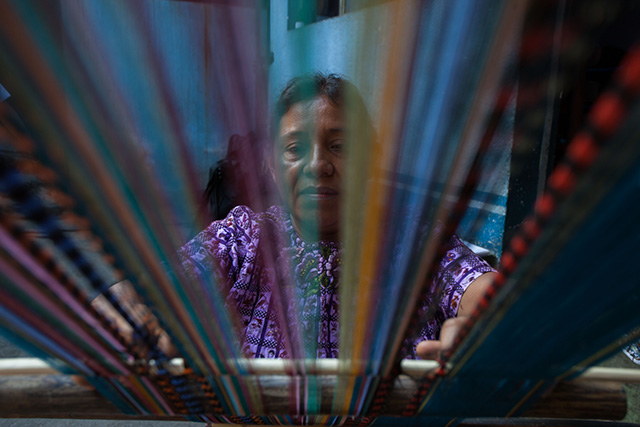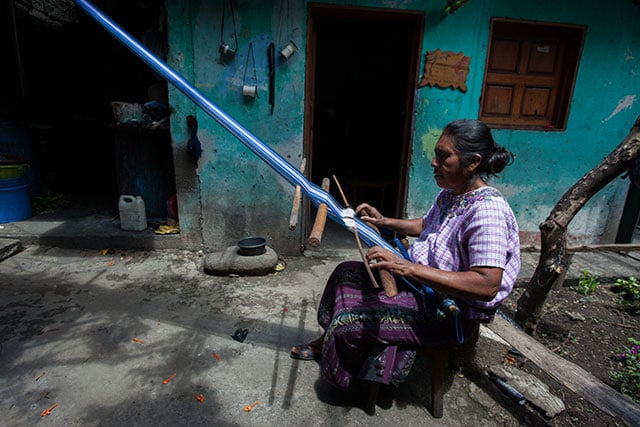
Guatemala’s Indigenous Mayan communities are doubling down in their struggle against the corporations that are increasingly seeking to turn aspects of their culture into commodities promoted to tourists. The struggle is just the latest front in their centuries-long resistance against the forces of conquest, imperialism and genocide.
Hundreds gathered outside the Guatemalan Congress and the Supreme Court on May 6 to demand that the government act to protect their sacred textiles from appropriation by both national and transnational companies, and on June 28, Indigenous activists testified at a public hearing in the Constitutional Court in Guatemala City.
“There is a strong appropriation of our designs and textiles,” Angelina Aspuac of the Women’s Association for the Development of Sacatepéquez (AFEDES), the organization spearheading this campaign, told Truthout. “This isn’t only the government, but more so, it is the companies that make bags, shoes, and belts with our designs without respecting how we see these pieces within our communities, or their significance in our communities. There are elements of our clothing that are sacred, that have a spiritual significance, and others that are only used in ceremonies or by the spiritual leaders in our communities.”
Currently, the laws of Guatemala do not protect the intellectual property rights of the designs of Indigenous clothing. This has left traditional Mayan designs open to theft by transnational companies looking to exploit and appropriate Mayan identity. The protesting communities and weavers have initiated a legal process at Guatemala’s Constitutional Court to demand that Guatemala’s Congress amend the national laws that govern national industry and industrial property rights to protect what AFEDES describes as the “collective intellectual property of Indigenous Peoples,” especially “in the case of textiles and Indigenous clothing.”
The plaintiffs in the legal process are not necessarily opposed to the use of their weavings by small producers, so long as these producers consult them in accordance with the International Labor Organization’s Convention 169 on the rights of Indigenous and tribal peoples, prior to the use of the weavings. (The convention states that governments and companies must consult Indigenous people prior to any projects that impact their culture or territory.)
What concerns the plaintiffs more is the use of their weavings by large companies and fashion designers. Guatemalan fashion designers have increasingly utilized Indigenous designs and clothing.
In 2011, Guatemalan fashion designer Giovanni Guzmán provoked outrage by using the traditional clothing of the male spiritual leaders of the K’iche’ Maya highland town of Chichicastenango for Miss Guatemala in the Miss Universe beauty pageant. Mayan leaders from across Guatemala condemned the designer’s use of the sacred clothing.
“The use of Mayan ceremonial dress is a clear violation of cultural and collective rights of Indigenous peoples,” wrote representatives of Indigenous authorities in a statement. “There is a lack of respect for the Indigenous Peoples of Guatemala. These pieces are exclusive to ancient Mayan authorities of profound significance, historical, cultural, spiritual and philosophical character.”
They added, “We are appalled and outraged, because of the misuse of our cultural possessions that follow and are sacred and bequeathed by our ancestors, therefore they are not objects for display and contamination.”
Other companies, such as the high-end designer handbag company, María’s Bags, utilize Indigenous weavings in their products, which sell for hundreds of dollars in Guatemala, the United States and Europe. The women of AFEDES have accused these companies of not only appropriating the indigenous weavings, but of overt racism as well. For example, they say that while the name “María’s Bags” may not be meant to offend indigenous women in Guatemala, it’s relevant to note that the word María is commonly used in a derogatory way to refer to all Mayan women. The bags marketed as “María’s Bags” are promoted to wealthy foreign and national tourists in tourist enclaves like Antigua Guatemala.
Currently the case primarily involves women from the departments (provinces) of Guatemala, Sacatepéquez, and Chimaltenango, but this case also affects Indigenous weavers across the country and many have expressed their support for it.
“We are supporting this action that AFEDES is taking,” Diego Petzey Quiejú, a young Tz’utujil Maya and weaver from Santiago Atitlan, told Truthout. “We are not able to be there physically in the court with them, but we are there spiritually with them. This is a necessary struggle.” However, according to Petzey Quiejú, one obstacle to gaining a broader support for the movement is the lack of awareness in many rural communities.
“No one here in (Santiago) Atitlan knows about this initiative,” Petzey Quiejú said. “There is nothing on the television, there is nothing on the radio, because there is no community radio station here. There are only publications on the internet, and it is primarily the youth that have access to these networks.”
“The system is quietly dispossessing us of our identity,” Petzey Quiejú added. “The government has influenced this process. When they publish various materials in the Guatemalan tourism ministry, INGUAT, they are objectifying the real significance of our weavings. It is necessary to defend our weavings. So they recognize that this is more than just work, it is our identity, it is our history, and it is the knowledge of our communities. As of now, the valorization of this is not happening.”
The appropriation of Indigenous designs by fashion designers and transnational companies in Guatemala reflects a growing situation internationally. Across the globe, Indigenous communities have organized to challenge the theft of sacred designs. In 2011, for example, the Navajo Nation sued Urban Outfitters for millions of dollars for the appropriation of their name for a clothing line. The tribe lost the two lawsuits, with the court claiming that the tribe’s trademark was “not famous enough.”
Last November, the Inuit Nation threatened the London-based Kokon to Zai (KTZ) with a lawsuit over the use of the designs of an Inuit spiritual leader’s clothing for a sweatshirt. The company apologized for the use of the design and removed the sweatshirt from stores.
Dispossession and the Commodification of Identity
 A member of the 13 B’atz’ weavers collective sits in the garden of her house in Santiago Atitla and using a backstrap loom to weave one of the famous pieces. (Photo: Jeff Abbott)
A member of the 13 B’atz’ weavers collective sits in the garden of her house in Santiago Atitla and using a backstrap loom to weave one of the famous pieces. (Photo: Jeff Abbott)
In Guatemala, the women of AFEDES argue that the nation’s government has appropriated Indigenous weavings as a means to attract tourism — and that the benefits do not make their way back to the community.
“Guatemala is dominated by tourism,” said Aspuac. “When the State wants to promote tourism, they use the Indigenous. They use the photos of the women with güipiles – the traditional blouse of the Indigenous women. But the reality is that the society is very discriminatory and exclusionary against our communities. The state is benefiting from our work, but we are still discriminated against because we look different, because we see the world differently, and because we dress differently.”
The rise of tourism as part of the “Mundo Maya,” a route of tourist attractions that includes Guatemala, Belize and Chiapas, Mexico, especially exacerbated this dispossession. At the heart of this promotion is the attempt to transform the Indigenous woman into a commodity while erasing histories of violence against Mayan communities.
At the height of Guatemala’s internal armed conflict many Indigenous Mayas were targeted because of their traditional clothing.
“They exhibited us in our native dress as if we were in a zoological park where people would come and pay them money to see us,” said Lucía, a former Guerrilla fighter, in the 1983 book Guatemala in Rebellion: Unfinished History, edited by Jonathan L. Fried. “They exhibit our clothes and with all this, without any effort of their own, they rake in money. The Government has used us, but now we are no longer lending ourselves to these games. Now we realized that instead of weaving another güipiles, we are better off picking up a weapon, picking up a bomb and throwing it in front of them.”
From 1960-1996, Guatemala was gripped in an internal armed conflict between Marxist Guerrillas and the Government. The war disproportionally impacted Indigenous communities, which represented a major proportion of the 200,000 people killed and 45,000 disappeared.
Following the signing of the Peace Accords on December 29, 1996, Guatemala’s Indigenous peoples began the process of the recuperation of their identity. But the arrival of transnational companies through neoliberal reforms guaranteed that they would continue to face dispossession.
Weaving Connections With the Ancestors
 Another member of the 13 B’atz’ weavers collective sits on the floor of the house as she weaves. (Photo: Jeff Abbott)
Another member of the 13 B’atz’ weavers collective sits on the floor of the house as she weaves. (Photo: Jeff Abbott)
Mayan communities have a long history of weaving, which is steeped in tradition. Weaving is a deeply spiritual process for Mayan weavers. It is a mystical connection between the living culture today, and its ancestors.
Each weaving is deeply rooted in the Mayan cosmovision and reflects knowledge held by the community. Indigenous clothing commonly depicts colorful birds, trees, mountains, animals and other parts of nature. The significance of each weaving is rooted to the place where it was made. These weaving practices and patterns stretch back thousands of years.
“We have had our weavings from before the Spanish conquest,” Petzey Quiejú told Truthout. “They did not come and impose these weavings, we had them before they arrived.”
As western culture has entered into the communities, many youth have chosen to leave behind their traditional clothing, thus growing more distant from their oral histories, which are woven into traditional clothing. But many other youth have continued to protect the stories that are woven into Mayan clothing.
“The phrase ‘dispossession of identity’ encapsulates what all Indigenous people of Guatemala are suffering from,” Petzey Quiejú said. “Fifty years ago, the majority of families made their own clothing, which [was] based in their relations with the cosmos; the weavings were not decorations, but rather something that had symbolic meaning that was connected with [the] life and nature that surrounded them. But then came the [capitalist] system, which told us that we needed money and you need these things. Families began to teach their children that they need these things, and little by little we’ve lost the connection with the meaning of the weavings.”
But there are a few young weavers, such as Petzey Quiejú, who are painstakingly continuing to weave these ancient understandings into their work and actively working to protect the Mayan culture and its symbols from being lost. He works along with his family and the other young weavers of the 13 Batz’ collective. Since 1997, his father, Bartolomé Petzey, has coordinated a collective of weavers in Santiago Atitlan. In addition to protecting Indigenous identity, the recuperation and protection of traditional weaving techniques provides work for many youth who might otherwise be forced to migrate north in search of employment.
According to the weavers, the weavings represent not only the past but also the future of the Mayan communities and a means of passing knowledge to future generations.
“The women have found a means to immortalize the knowledge and understanding of our ancestors within the güipiles,” Aspuac told Truthout. “We worry that we are losing this philosophy and understanding. Many youth are not learning to weave, or to use the traditional clothing. So we’ve worked to recuperate the knowledge.”
Media that fights fascism
Truthout is funded almost entirely by readers — that’s why we can speak truth to power and cut against the mainstream narrative. But independent journalists at Truthout face mounting political repression under Trump.
We rely on your support to survive McCarthyist censorship. Please make a tax-deductible one-time or monthly donation.